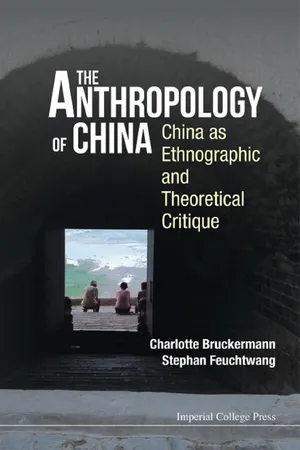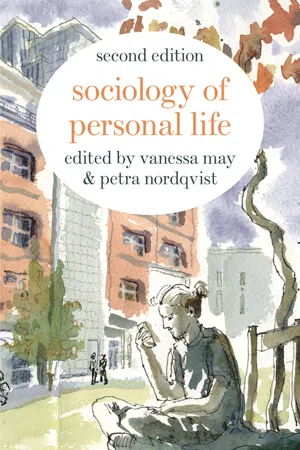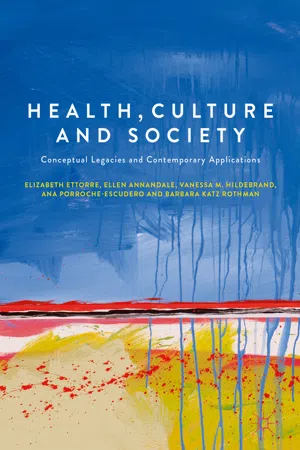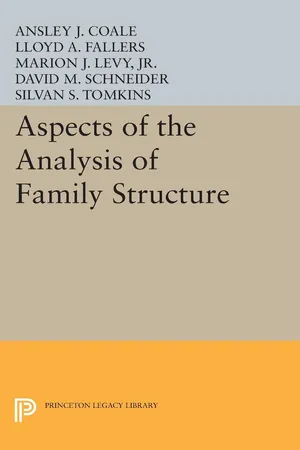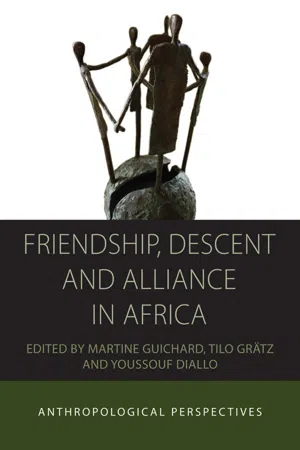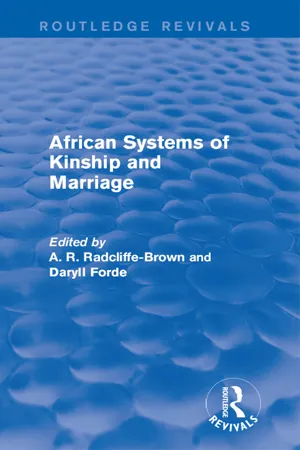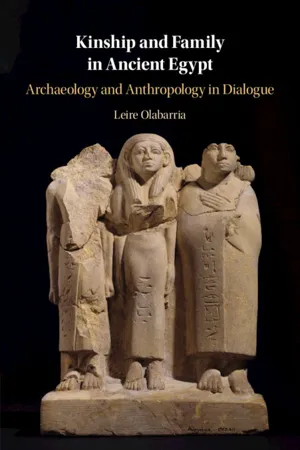History
Kinship in Africa
Kinship in Africa refers to the complex system of social relationships and connections based on blood ties, marriage, and adoption. It plays a crucial role in African societies, shaping social organization, inheritance, and political structures. Kinship also influences economic activities, religious practices, and the transmission of cultural traditions across generations.
Written by Perlego with AI-assistance
Related key terms
1 of 5
10 Key excerpts on "Kinship in Africa"
- eBook - ePub
- Maria Grosz-Ngaté, John H. Hanson, Patrick O'Meara, Maria Grosz-Ngaté, John H. Hanson, Patrick O'Meara(Authors)
- 2021(Publication Date)
- Indiana University Press(Publisher)
News accounts of violent conflict in Africa frequently make reference to “tribe” and “tribalism” as potent ingredients of discord. The use of “tribe” in the African context is a legacy of colonialism and the research of early anthropologists. Anthropologists wanted to know how African societies without centralized leadership maintained order and stability while colonial officials demarcated African societies for the purpose of rule, ignoring complexities, interactions between groups, and the fluidity of boundaries. The persistent characterization of African populations as “tribes” gives the appearance of timelessness and glosses over the different forms of political organization that existed in the past. It implicitly suggests that tribe (or ethnic group) is the primary source of identity and mode of sociopolitical organization on the continent. It also obscures the existence of more important forms of identification, relatedness, and belonging that may play a role in, counteract, or facilitate the resolution of conflict. Like people in other parts of the world, Africans are enmeshed in a range of institutions and identify with multiple collectivities. An individual may be a mother, wife, sister, and daughter; a cultivator, cloth dyer, or teacher; a member of an age group, a participant in a local or national women’s association, and a member of an ethnic group as well as a citizen of a nation-state. These social positions and identities overlap and cross-cut each other; which of them takes precedence at any given time depends on the context.This chapter focuses on social relations as lived and constructed through kinship, marriage, and forms of association beyond the family. It illuminates the diverse ways in which individuals negotiate these institutions and the changes taking place as a result of the day-to-day actions of African women and men in the context of historical, political, and economic processes that impinge on their lives. Social relations are dynamic and change is not new; yet transformations are often subtle before they become visible or acknowledged as a result of an event that brings them to the fore. Africans may highlight continuity when asked about specific practices. At the same time, older people contending that young people act very differently than they themselves once did often ignore the variability that already existed during their own youth.FORMS AND MEANINGS OF KINSHIP
Drawing on Western models of economic transition, twentieth-century modernization theorists assumed that the importance of kinship bonds would diminish once African economies developed and state institutions created a social safety net. Yet kinship has not lost its salience as a moral order that structures relationships and guides people’s actions as they meet the challenges of contemporary life. Anthropologists have used the concept of “kinship” to understand who gets counted as “family” in different African societies.1 - eBook - ePub
The Anthropology of China
China as Ethnographic and Theoretical Critique
- Charlotte Bruckermann, Stephan Feuchtwang(Authors)
- 2016(Publication Date)
- ICP(Publisher)
Chapter 3
Kinship as Ideology and as Corporation
In anthropology, the study of kinship has a long held pride of place in the disciplinary showcase, not least as the discipline could offer unique insights. The anthropological study of kinship found footing somewhere between the individual focus of psychology and the institutional dynamics traced by sociologists. In many ways, anthropologists of kinship stood on middle ground between the two, while simultaneously offering perspectives well beyond the remit of the Western academy and normative nuclear families associated with modernity.Anthropological studies of kinship over the course of the last two centuries have provided particularly fertile ground for offering accounts of human diversity, not least due to kinship’s universal role in reproduction, both in terms of procreation and political economy. Building on biological and biologistic premises many kinship studies assumed reproductive connection as the self-evident basis for kinship earlier, but more recent research has questioned whether anthropologists were not, after all, relying on Western folk models themselves and exalting them to the level of universal science.Questioning what has been naturalized through assumptions about kinship also provided ways of investigating political and economic orders that deviated from Western states. In Africa, particularly, anthropologists analyzed lineages as complex kinship systems that provided relatively stable distributions of power and resources in the absence of centralized states. By contrast, in China kinship and the state were interwoven in a long and complex history, despite sharing some institutional similarities with African lineages. This chapter will explore these historical dimensions of kinship in China, and explore what this can tell us about different types of cognition, through which we understand the world. - eBook - ePub
Cultural Anthropology
A Christian Perspective
- Stephen A. Grunlan, Marvin K. Mayers(Authors)
- 2016(Publication Date)
- Zondervan Academic(Publisher)
Kinship is more than a network of biological relationships; it is also a network of social relationships. It establishes social ties, patterns of behavior, obligations and responsibilities, and patterns of authority. In short, it is a “road map” or structure of interpersonal relationships.Among the aborigines of Australia, when two strangers meet they do not greet each other until they have determined how they are related so that the proper greeting may be used. If they determine they are not related, they try to kill each other. As might be expected, the aborigines practice exogamy to expand their kinship network.Kinship relationships are the basis of the social structure in most nonwestern societies. This is true not only in small villages but also among large tribes. The Nuer of the Sudan in Africa number over one hundred thousand. Yet, they have no political or legal authority structure. There is no king, chief, or ruling council. Nevertheless there is social order, economic development, and organized defense. The Nuer social structure is based on a kinship system. The society functions by the obligations and responsibilities of kinship. How can a society this large maintain social order without a political or legal authority system? Does a North American mother call the police to make her son take a bath? No; yet he takes a bath. In the same way the Nuer family has the power and the responsibility to control its members. - eBook - PDF
- Vanessa May, Petra Nordqvist, Vanessa May, Petra Nordqvist(Authors)
- 2019(Publication Date)
- Bloomsbury Academic(Publisher)
Today, it is more common that they are understood through reference to genes or DNA. The idea that families are ‘natural’ communities of people who share blood or genetic DNA remains power-ful, however, and is part and parcel of the idea that family bonds are in no sense ‘chosen’ but are simply ‘given’. SOCIOLOGY OF PERSONAL LIFE 48 A common cultural image of a kinship group that encapsulates both the idea that kinship is something ‘fixed’ and unending, and defined by biological connections, is the genealogical family tree. This is a rep-resentation of the family as a tree where the branches represent the link between a child, her or his parents, their parents, and so on. The tree conjures up the image of a family line that can be traced back through time, and also an image of family as a self-explanatory community that can be readily defined and which is ‘self-evidently’ there to look at. However, when looking at kinship and the meaning of being related (or relatedness ) from a sociological perspective, a more complex picture starts to emerge. When we step away from the cultural idea of kinship as a natural and fixed relationship, expressed in the image of the family tree, and instead look at what being related means to people in terms of their everyday life and experience , a series of questions starts to emerge that troubles the idea that kinship is straightforward or ‘fixed’. - eBook - PDF
Health, Culture and Society
Conceptual Legacies and Contemporary Applications
- Elizabeth Ettorre, Ellen Annandale, Vanessa M. Hildebrand, Ana Porroche-Escudero, Barbara Katz Rothman(Authors)
- 2017(Publication Date)
- Palgrave Macmillan(Publisher)
103 © The Author(s) 2017 E. Ettorre et al., Health, Culture and Society, DOI 10.1007/978-3-319-60786-3_5 5 Kinship, Blood and Alliances Ana Porroche-Escudero Introduction Since the beginning of anthropology there has been a long tradition of studying kinship. Its focus on marriage, family and motherhood was not accidental and coincided with a particular historical period in the West when the nuclear family was emerging, exalted by the middle classes. This understanding of the family underscores the role of femininity in sustain- ing marriage and reproduction. Decades later, some sociologists and anthropologists argued that kin- ship studies were “dead”. Kinship was thought to be irrelevant at least in the “West”, where postmodern societies are supposed to be sexually pro- gressive and free from problems such as arranged marriage, compulsory motherhood or homophobia (Jackson and Scott 1996). But it is precisely at times such as these, characterised by “sexual antinomies” (Jackson and Scott 2004) and fuelled by conservative forces, that people are more likely A. Porroche-Escudero (*) NIHR CLAHRC NWC, Lancaster University, Lancaster, UK 104 to be concerned with the purity of the family (Esteban 2008; Pichardo- Galán 2009) and womanhood (Jolly et al. 2013: 19). Even when popular and academic discourses claim that new models of family and parenting make kinship more equal and happier than even before, feminist scholars have warned that the time is not for compla- cency. They argue there is a need to visualise how traditional ideologies concerning kinship continue to apply hierarchies of kinship, reflecting existing social hierarchies and having profound implications on people’s lives and well-being. - eBook - PDF
- Ansley Johnson Coale, L. A. Fallers, Philip Burke King(Authors)
- 2017(Publication Date)
- Princeton University Press(Publisher)
KINSHIP AND BIOLOGY DAVID M. SCHNEIDER PROFESSOR LEVY defines kinship structure as "that portion of the total institutionalized structure of a so- ciety that, in addition to other orientations, some- times equally if not even more important, determines the membership of its units and the nature of the sol- idarity among its members by orientation to the facts of biological relatedness and/or sexual intercourse." Except for its careful phrasing, this definition is hardly new. It is the definition the natives of Europe and America now use and have used for at least the past two thousand years. It is the same definition which social scientists now use and have used for the last hundred years or so. What could possibly be wrong with a definition of such antiquity? What could be wrong with a defini- tion which is so widely held by specialist and layman alike? What could be wrong when the folk-definition and the scientific definition are in such fine agree- ment (allowing, of course, for the special lucidity of Professor Levy's prose)? Is it possible that the folk theory is scientifically correct? Or could it be that the scientific theory has made no progress in the last hundred years? Let me start this comment by stipulating certain facts, or what I take to be facts. First, most social scientists do use a definition of kinship similar to that which Professor Levy offers us. ITie phrasing may differ here and there, but the intent is clear. Sec- ond, most cultures in the world about which we know anything have institutions or customs which 83 Kinship and Biology do, as Professor Levy says, determine the member- ship of its units ". . . by orientation to the facts of biological relatedness and/or sexual intercourse." Third, there is, or there should be, a set of analytic definitions and distinctions which may or may not coincide in some part with the folk categories, or the cultural definitions of a particular society. - eBook - PDF
Friendship, Descent and Alliance in Africa
Anthropological Perspectives
- Martine Guichard, Tilo Grätz, Youssouf Diallo(Authors)
- 2014(Publication Date)
- Berghahn Books(Publisher)
Yet, the spectre of kinship haunts friendship in multiple ways. To begin with, it is clear that institutions associated with kinship such as rules of inheritance and rules of postnuptial residence have consequences for friendship ties all over the world (Chapter 1). The same holds true for incest taboos which, given their importance in the constitution of kinship, can be assumed to play an important role in conceptualizations of friendship as another form of social relationship. As emphasized by Paul Spencer (Chapter 2), changes occurring in the domain of clanship and descent also have repercussions for friendships. Among the Kenyan and Tanzanian Maasai, friendships between men often grow out of experiences made after having become initiated as junior warriors and during the time they live apart from their families with their own age mates. During the years they spend together in villages separated from their kin, the junior warriors get the opportunity to bond with each other at the interpersonal level. They also increas-ingly become committed to an ethos of collective comradeship. This ethos, which condemns overt displays of intense, dyadic friendships, gained significance with the decline of clanship in the second half of the nineteenth century. The decreas-ing emphasis on clan and descent ties led to a transformation of the role of age-set membership with regard to the application of incest and exogamy rules. This role increased and by now incest and marriage avoidance among the Maasai concerns age-set ‘daughters’ more than clan ‘sisters’. As pointed out by Spencer, such a con-figurational type involving the exchange of women as a binding force between different generations rather than between different descent groups was neglected by Lévi-Strauss in his alliance theory (1969 [1949]). Nonetheless, for Lévi-Strauss, alliance is fundamentally an exchange of women between groups. More basically, however, it is an exchange of women between men and through men. - eBook - ePub
- A. R. Radcliffe-Brown, Daryll Forde(Authors)
- 2015(Publication Date)
- Routledge(Publisher)
Likewise, an affine is conyimar, husband of sister, conyal, husband of daughter, or of some other affinal category, and is addressed as gwa, father, demar, my brother, or gatda, my son, as the case may be. Lineages are articulated as groups of agnatic kin at a different situational, usually ritual, level of the social life and are articulated as conglomerates fused with other elements at yet a different situational, the political, level. Kinship ties belong to another order of social relations, relations between persons and not between groups. The members of a lineage group are socially undifferentiated as such in the interlineage structure because it is a structural relationship between groups. In the kinship system they are socially differentiated—this being an essential characteristic of the system—because the kinship system is a system of relationships between persons. As we have seen, members of a Nuer community are all mar, kin, to one another. Whoever is kith must also be kin. Common membership of a village or camp does not in itself provide a man with a secure basis for his personal relations with its other members. That is provided chiefly by the kinship system by which a kinship tie established with any person in the village or camp gives a man a kinship status of some kind with every other person in the village or camp, with all his neighbours. A village or camp is a community of kin. This means that from the point of view of any of its members the other members are his kindred (including affines in this term) and also that he knows, at any rate more or less, in what way any one of them is related to a third person. It does not, however, mean that together they constitute a specific kinship group - eBook - PDF
Bridging Mobilities
ICTs Appropriation by Cameroonians in South Africa and The Netherlands
- M. Nyamnjoh(Author)
- 2013(Publication Date)
- Langaa RPCIG(Publisher)
Kinship relations and networks and the large number of Pinyin migrants can be traced back to the first Pinyin migrant who went to South Africa in 1996. The network chart below shows a network of transnational kinship rela-tionship. Since his arrival in 1996, Joe has brought in his immediate nuclear fam-ily (his wife and three sons) and has also brought in four siblings and some close friends and has provided information for others who may follow. In addition, he has assisted newcomers with settling in. By kinship, we mean blood relations or relatives by marriage and the individ-ual nuclear family, or close relations marked by community ties. This kinship network is also informed by the Pinyin adage that ‘when a Pinyin man discovers a fertile ground he paves the way for many to follow’. 7 Earlier migrants became not only the communication outpost for those who remained behind but also cre-ated a bridge for others to follow. In this regard, kinship relations are seen more as a continuum than as a disjointed movement of individuals. This leads to chain 7 Conversation with Papa Gabriel, Pinyin; 21/05/2010. Chapter 5: Networks and shifting relations 123 Diagram 5.1 Chart showing network connections and expansion (thanks to Joe) migration, something MacDonald & MacDonald (1964) defined as ‘that move-ment in which prospective migrants learn of opportunities, are provided with transportation, and have initial accommodation and employment arranged by means of primary social relationships with previous migrants’ (cited in Choldin 1973: 164-165). There is ample evidence from the literature on kinship relation-ship as well as empirical data from this study to substantiate the fact that these ties are the most important and well preserved. They are sought after in pre-migration, migration and post-migration periods, and are the most tapped from (Prelipceanu 2008; Choldin 1973; Pelican et al . 2008; Fleischer 2006). - eBook - PDF
Kinship and Family in Ancient Egypt
Archaeology and Anthropology in Dialogue
- Leire Olabarria(Author)
- 2020(Publication Date)
- Cambridge University Press(Publisher)
This interaction with ancestors contributes to preserving the cohesion of extended families, with tombs often acting as foci of collective memory (Adams 2010: 15; Moreno García 2010: 153; Richards 2010: 137–8). In this manner, commemoration of the deceased members of the kin group resurfaces again as a fundamental duty that related- ness entails. KIN GROUPS, DISPLAY AND THE PRACTICE OF RELATEDNESS Complying with my approach to ancient Egyptian kinship as relatedness, the six attributes discussed in the previous sections are all based on practice, i.e. on what someone who would be defined as a relative would do. As a result, whether or not someone is considered a member of a kin group is circumstan- tial and strictly context-bound. Such a non-essentialist stance must necessarily be based on contextual information that is provided, often indirectly, by our interpretations of the primary sources. By basing my definition of relatedness on practice as extracted from ancient Egyptian evidence, I am aiming to avoid the fallacy of blood, which is not applicable to societies outside the modern Euro-American context (Olabarria 2018b: 92–3). Genealogy, while extremely important in ancient as well as modern cultures (see the section ‘Filiation KIN GROUPS, DISPLAY AND THE PRACTICE OF RELATEDNESS 93 Formulae and the Genealogical Myth’ in Chapter 6 for filiation as a tool to reconstruct genealogies), is only one aspect of relatedness that can be – and is – manipulated to adjust to the needs of the people involved. Conse- quently, even this feature needs to be considered with care. In short, the notion of relatedness applied to ancient Egypt shows that kin groups encom- pass people who behave as relatives, rather than simply people who are relatives. Kin group is understood as a polythetic classification that comprises all six attributes in a way that is flexible and non-exclusive.
Index pages curate the most relevant extracts from our library of academic textbooks. They’ve been created using an in-house natural language model (NLM), each adding context and meaning to key research topics.

